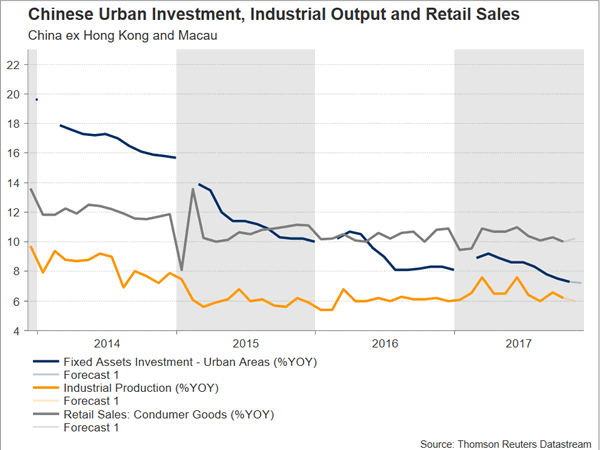China will see the release of figures on November fixed asset investment, industrial production and retail sales on Thursday at 0200 GMT. The data are not just important for the world’s second largest economy, but also Australia, which has China as its major exports destination.
The annual pace of growth for fixed asset investment in urban areas is expected to stand at 7.2%, reflecting a minor slowdown from October’s respective rate of 7.3%. November’s industrial output is anticipated to grow by 6.0% on an annual basis, slightly easing from the preceding month’s 6.2%, while retail sales are projected to rise by 10.2% y/y, exceeding October’s 10.0%.

Should fixed asset investment decline as expected, then this would mark the eighth consecutive month of declines for the measure. It should also be pointed though, that if projections materialize, the reading would still expand at a robust pace.
It should be kept in mind that the slowdown in certain readings in the latter part of the year is coming on the back of government efforts to reduce financial risks as well as curb pollution, with efforts on the latter possibly acting as a drag on industrial output. The reasoning behind such actions is that Chinese authorities are increasingly placing emphasis on the quality of growth rather than merely the quantity; more balanced growth was pledged during the five-yearly Communist Party Congress in October and the first steps to achieve that goal are seemingly being taken. This has the capacity to result in a weaker outlook for growth, but at the same time it would facilitate the sustainability of growth, reducing risks for extreme adverse conditions further ahead.
On the retail sales front, Alibaba’s promotions during the so-called "Singles’ Day" in November is likely to have acted as the catalyst for the forecasted increase in sales.
Besides movements in the yuan, Australia’s strong economic ties with China would place the aussie in the spotlight as the above data become public – the Australian currency is considered a liquid proxy for China’s economy.
An upside surprise in the figures could boost aussie/dollar. In such an event, the pair might meet resistance at around 0.7643, this being the 23.6% Fibonacci retracement level of the September 8 to December 8 downleg. Bear in mind, that the area around this mark also encapsulates the December 5 one-month high (0.7653), as well as the current levels of the 50- and 200-day moving averages (0.7671 and 0.7689 respectively).
If the data disappoint though, forex market participants could push the pair lower. In this case, aussie/dollar might find support around the six-month low of 0.7498 that was recorded on December 8.

It should be noted that Australian data on employment (and unemployment) for the month of November due earlier on Thursday (0030 GMT) are likely to act as market movers for the aussie as well.












